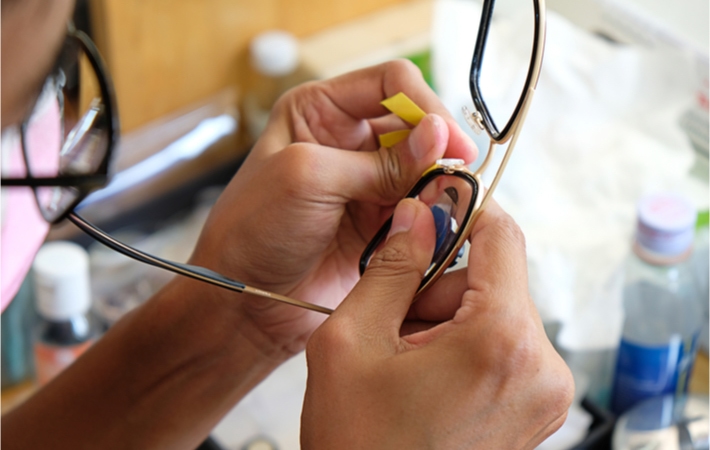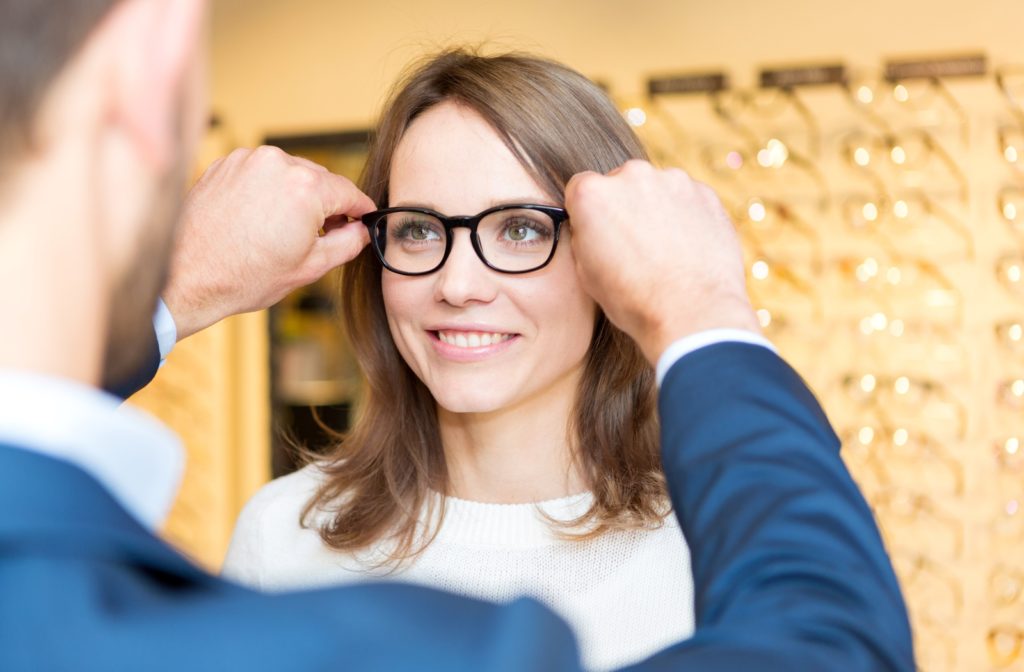How Should Eyeglasses Fit?
The right pair of glasses help you see better and make you feel good about yourself. The perfect fitting spectacles provide total comfort and give you crystal clear vision to see the world. But how do you know if your frames are fitting their best?
Making sure your eyeglasses fit just right requires a few key measurements and a little bit of knowledge about what to look for. But there’s nothing better than finding your perfect frames after your annual eye exam.
Whether you’re shopping for frames for yourself, glasses for your children, or need the right pair of sunglasses, it’s ALWAYS important that they fit right. Come visit our friendly opticians for some glasses guidance or use our Personalized Glasses Survey for an eyewear concierge experience.
Frame Knowledge 101
To know what exactly a perfect fit means, you need to have some eyeglass terminology down. So let’s review the parts and pieces of a typical pair of glasses. The American Academy of Ophthalmology lists 9 essential parts of eyeglasses. Here they are!
Lenses
Lenses are what you see through! Typically made of polycarbonate or plastic, these are the windows through which you see the world. Your lenses are centered over your eyes with any properly fitting pair of glasses.
Rims
The rims are the part of the frame that’s shaped around the lenses. The rims serve for both function and fashion. They hold the lenses in place and also add a ton of character to the look of your glasses.
Temples
Sometimes called “arms”, these are the long parts of your frames that run along the side of your head. The temples keep your glasses on your head and are what give a snug fit.
End Pieces
These are the little “nubs” on each side of the rims that jut out and connect the temples to your rims. In some styles, such as cat-eye glasses, these pieces can be very exaggerated to create a dramatic look.
Hinges
Eyeglass hinges connect the temples to the end pieces. They allow you to fold your glasses for convenience and frame protection.
Screws
This is pretty simple. The screws are located at the hinges and fasten the pieces together.
Bridge
This is the center part of your frames and another piece that can have a big impact on your spectacle style. The bridge rests over the nose and joins the rims together.
Pad Arms
Pad arms shoot down from the rims, connecting the nose pads. They are usually adjustable and can be shaped to fit your nose perfectly.
Nose Pads
These are small plastic pads that sit under the bridge and sit on your nose. Nosepads create a more snug and secure fit, but not all glasses frames have nose pads.
The Perfect Fit Formula
It all comes together when your frames sit just right on the nose, aren’t too loose or too tight on the head, and you are staring right through the center of your lenses. But let’s get a bit more technical about how your eyeglasses should fit.
Bridge Width
As mentioned, the bridge is the part of your glasses between the rims (and lenses) that rests above your nose. The bridge fit is one of the key elements to look for in eyeglasses that are properly worn. WE want to make sure the bridge width matches your face.
Bridge width is simply a measure of the length of the bridge. The right measurement for your fit depends on the size of your head, the size of your nose, and the style of glasses you’ve selected.
There are 3 general classifications of bridge width:
- Small: 14mm to 16mm across
- Medium: 17mm to 19 mm across
- Large: 20mm to 23 mm

Bridge FIt
The right bridge fit should feel comfortable, even if you’ve been wearing your glasses for several hours. Whether or not your glasses have nose pads, there are some frame fit no-no’s that indicate you’ve got the wrong bridge width or the wrong sized frames overall:
- Glasses slip off of your nose during normal activity.
- Nose pads are leaving painful impressions after wear.
- The bridge is digging into your nose.
- Frame rims are resting on your cheekbones.
If these are occurring, it’s time to find some frames that rest easy on your nose.
Eyes Centered
The most important thing about wearing prescription glasses is making sure that they actually improve your vision. To do this, the lenses must be in the right place relative to your pupils. Your pupils are the black center of your eyes that allows light in. These need to line up with the middle of your lenses.
Now, your pupils don’t have to be in the dead center of your lenses with every pair of glasses you wear, but they should be close. Different styles and frame sizes may alter the exact positioning of your lenses, but here are some rules that should always be followed:
- Vertically, your eyes should NEVER be centered in the bottom ½ of the lenses. It’s okay to be centered slightly above. But pupils should never be centered in the top ¼ of the lenses either.
- Horizontally, your eyes should be quite close to the center of the lens. Your pupils should NEVER be positioned outside the halfway line of the lenses. But there is a small allowance of up to 5mm towards the inside of your lenses
In a nutshell, you want to be looking through the middle of your lenses. Lenses are manufactured with this principle in mind, and this allows you to maximize the effectiveness of your prescription. Keeping your line of sight in the middle of the lens helps improve your peripheral vision, too.
Pure Comfort
Quite simply, your eyeglasses should be comfortable! This means no squeezing on the sides of your head and no digging into your ears, the side of your face, or the bridge of your nose. When this is happening, you probably have the wrong sized frames. Perfect fitting glasses should feel like they’re not even there.
Glasses that don’t fit right are going to give you troubles that won’t go away. Ill-fitting glasses can contribute to:
- Blurry vision (even with an accurate prescription)
- Vertigo
- Headaches
- Feelings of fatigue
Prescription Compatibility
No matter what style of eyewear you prefer, you want to make sure that your prescription is compatible with the frames you want. But don’t worry — that’s our job!
Most of the time, your prescription will work with the frames you prefer. But sometimes, especially for people with severe astigmatism or other complications, your lenses may not fit in every set of frames. Our opticians will always steer you in the right direction and ensure that the styles you seek are lens-friendly.
A Look You Love
The right fit, for any piece of clothing or accessory, is also about the way you feel about it. So finding the perfect fitting eyeglasses means finding the frames you absolutely love! After all, you might wear your glasses every day.
Our opticians love helping you fall in love with frames that express exactly who you are. The perfectly fitting glasses that match your fashion and lifestyle are out there! So don’t settle or get discouraged. Let our eyewear experts introduce you to eyeglasses that make you smile every time you look in the mirror.
Peace of Mind Professional Fittings
Your eyeglasses are an extension of your personality. They should express who you are but also fit right and function effectively. Putting all these things together can be tricky, but McCulley Optix Gallery has a team of experts to lead you to eyewear happiness.
A professional fitting with an optician will set your spectacles straight from the onset. You’ll know the pair of glasses you select is compatible with your vision and there’s no need for constant frame adjustments because you chose the wrong size or shape.
For the most complete experience in concierge eyewear selection, use our Personalized Glasses Survey to have an expert pick out some frames that qualify for everything you’re looking for and everything your vision needs.



